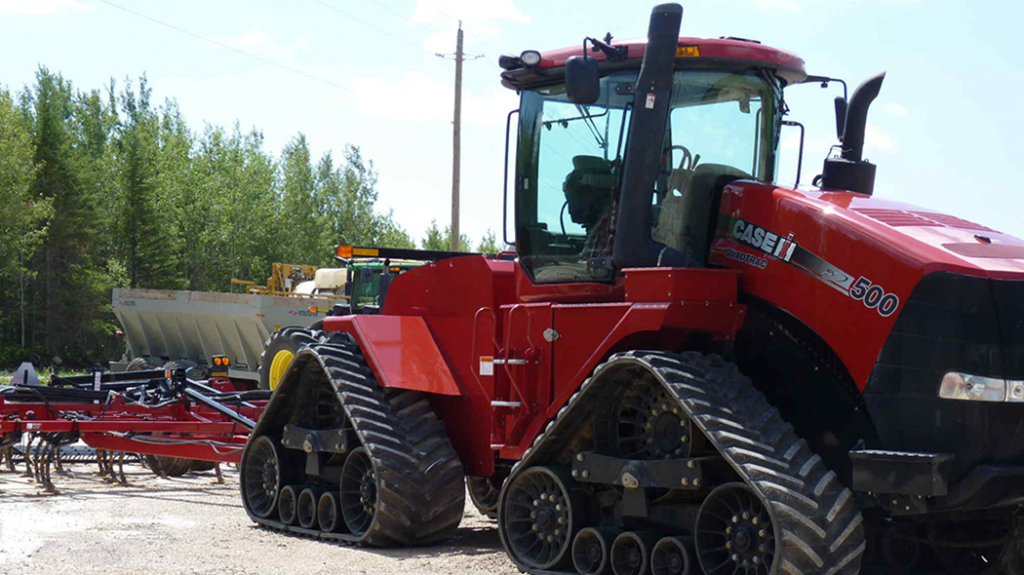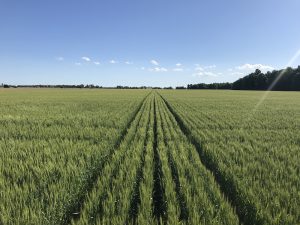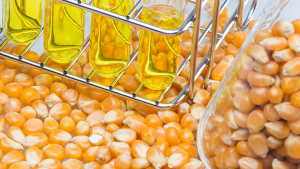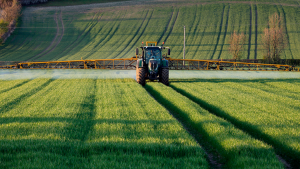Reducing compaction
TRACKED TRACTORS AND TIRE DEFLATION

DEPENDING ON A particular farm’s soil profile, compaction is a bigger issue for some grain farmers in Ontario than others. However, all are aware it must be minimized. As Dr. Richard Heck, professor in the School of Environmental Sciences at the University of Guelph, explains, surface and subsurface compaction due to machinery traffic continues to be a major problem facing the province’s crop farmers.
“Degradation of the soil structure due to compaction generally reduce aeration, thereby negatively impacting soil biological activity — including root development and soil exploration — and ultimately impacting crop performance in the long-term as well as in the short-term,” he explains. “It’s not simple to determine the potential loss of revenue that compaction can cause. The loss might be due to reduced yields or increased expenditures associated with greater tillage/planter draft or both. And both these factors are complicated by the variety of soil types and cropping systems that may be used on a specific farm.”
One trend affecting all of Ontario, however, is the increase in average farm size, and with that the use of larger, heavier equipment that causes more compaction. Higher wheel loads cause increased soil compaction at depth, whereas larger wheels with their increased surface area cause more compaction at shallower depths and less compaction at greater depths.
“In addition,” Heck says, “our weather is becoming increasingly unpredictable due to climate change, which can also increase the compaction risk.”
EXISTING TECHNOLOGIES
Two available solutions are track-based (instead of wheel-based) tractors and implements and remote-activated tire deflation/ re-inflation systems. These systems have been available for tractors for several years and some farmers in Ontario have put them into use. However, Heck points out that the impact of such solutions, relative to soil texture, management system (tillage, rotations, etc.), and moisture status is still not fully understood, especially in terms of soil structure impact.
Two years ago, Heck began a compaction research project with University of Guelph colleagues Dr. Adam Gillespie, Dr. Alex Barrie and Dr. Ian McDonald, as well as Danish colleague Dr. Lars Munholm. A PhD student, Olatunbosun Ayetan, has also joined the team. However, as was the case with many recent research projects, the pandemic impeded progress, and then again during fall 2021, field trials were not possible.
“The issue was not being able to source the tractors, primarily due to supply chain related issues,” says Heck. “We are now hoping to proceed during spring 2022.”
The results will help farmers more effectively select a solution to extend their window of operations on the field while still minimizing undesirable impacts on soil structural quality.
“They will also guide growers in the refinement of Best Management Practices for preserving soil structural integrity,” says Heck. “Lastly, the results will also be useful to machinery manufacturers and retailers, and further our collective scientific understanding of soil behavior.”
The project also includes the development of strategies to minimize and remediate impacts of soil compaction on soil health and the development, evaluation, and/or improvement of the resolution of testing procedures to measure key soil health parameters. Whether quantitative indicators of soil 3D microstructure can be used as tools for evaluating the degree of soil compaction will be determined.
SENSOR DATA
Getting a full sense of how much track-based and tire deflation strategies might decrease the impact of compaction pressure on topsoil and subsoil means taking different measurements using several devices.
“We are merging three main measurements,” Heck explains. “These are advanced in-field pressure sensing techniques and penetrometer resistance, with high-resolution x-ray CT imaging and micro-penetrometer profiling of intact soil cores, with conventional soil physical characterization of parameters like density and moisture retention.”
Gillespie’s research is focussing on the role of organic matter in mitigating compaction.
The trials are comparing track-equipped tractor/load assemblies with wheel-based ones involving both upper and lower recommended inflation pressures. The trials are also taking place on a range of soil textures — coarse, medium, and fine-textured — but all fields are zero-till.
In terms of crops, Heck explains that “the direct focus of this research will be on field crops — corn, soybeans, and wheat — but because we are considering the impact of agricultural machinery on soil in general, it is relevant to all types of crops and soil management systems.”
In the trials, cropping history and moisture status of all trial fields is also taken into account.
USING RESULTS
If track-based farm machinery is found by Heck and his colleagues to be significantly better in terms of reducing soil compaction — and other studies have already found this — this does not mean widespread adoption will occur. Conventional wheeled tractors are less costly, better for travelling distances between farms, and have other operational advantages. (The other solution of deflating tires reduces tractor pull capacity, but it also reduces fuel consumption by up to 15 per cent.)
Equipment Ontario (formerly Stoltz Sales & Service), with five locations in southern Ontario, has sold tracked equipment for more than 15 years. Owner Marlin Stoltz says low speeds and high costs have impeded adoption, but speeds have improved. His tracked sales have been less than one per cent, and to farmers who want to reduce compaction and whose topography makes wheeled equipment inefficient. Stoltz has two new orders for tracked equipment for 2022 so far.
This project was funded in part by the Ontario Agri-Food Innovation Alliance, a collaboration between the government of Ontario and the University of Guelph. •


























